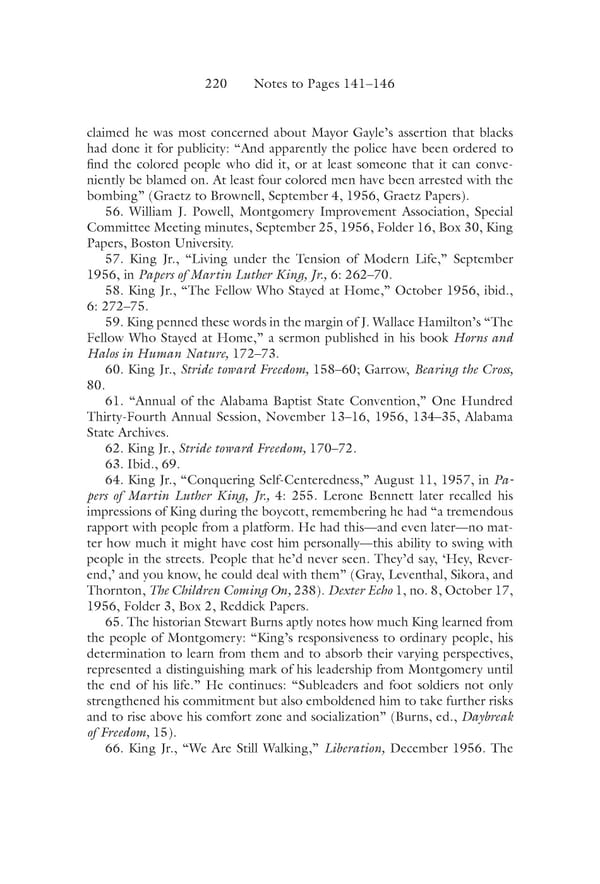220 Notes to Pages 141–146 claimed he was most concerned about Mayor Gayle’s assertion that blacks had done it for publicity: “And apparently the police have been ordered to find the colored people who did it, or at least someone that it can conve- niently be blamed on. At least four colored men have been arrested with the bombing” (Graetz to Brownell, September 4, 1956, Graetz Papers). 56. William J. Powell, Montgomery Improvement Association, Special Committee Meeting minutes, September 25, 1956, Folder 16, Box 30, King Papers, Boston University. 57. King Jr., “Living under the Tension of Modern Life,” September 1956, in Papers of Martin Luther King, Jr., 6: 262–70. 58. King Jr., “The Fellow Who Stayed at Home,” October 1956, ibid., 6: 272–75. 59. King penned these words in the margin of J. Wallace Hamilton’s “The Fellow Who Stayed at Home,” a sermon published in his book Horns and Halos in Human Nature, 172–73. 60. King Jr., Stride toward Freedom, 158–60; Garrow, Bearing the Cross, 80. 61. “Annual of the Alabama Baptist State Convention,” One Hundred Thirty-Fourth Annual Session, November 13–16, 1956, 134–35, Alabama State Archives. 62. King Jr., Stride toward Freedom, 170–72. 63. Ibid., 69. 64. King Jr., “Conquering Self-Centeredness,” August 11, 1957, in Pa- pers of Martin Luther King, Jr., 4: 255. Lerone Bennett later recalled his impressions of King during the boycott, remembering he had “a tremendous rapport with people from a platform. He had this—and even later—no mat- ter how much it might have cost him personally—this ability to swing with people in the streets. People that he’d never seen. They’d say, ‘Hey, Rever- end,’ and you know, he could deal with them” (Gray, Leventhal, Sikora, and Thornton, The Children Coming On, 238). Dexter Echo 1, no. 8, October 17, 1956, Folder 3, Box 2, Reddick Papers. 65. The historian Stewart Burns aptly notes how much King learned from the people of Montgomery: “King’s responsiveness to ordinary people, his determination to learn from them and to absorb their varying perspectives, represented a distinguishing mark of his leadership from Montgomery until the end of his life.” He continues: “Subleaders and foot soldiers not only strengthened his commitment but also emboldened him to take further risks and to rise above his comfort zone and socialization” (Burns, ed., Daybreak of Freedom, 15). 66. King Jr., “We Are Still Walking,” Liberation, December 1956. The
 Becoming King: Martin Luther King Jr. Page 240 Page 242
Becoming King: Martin Luther King Jr. Page 240 Page 242